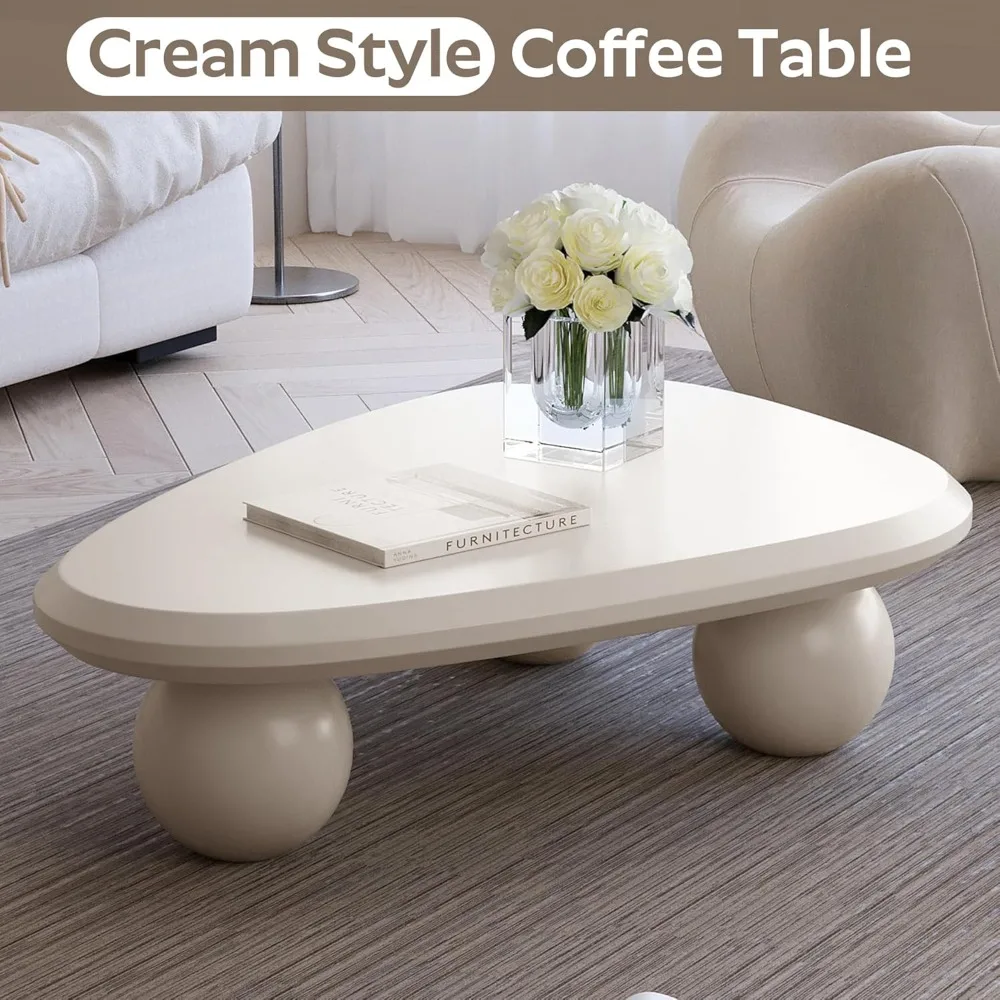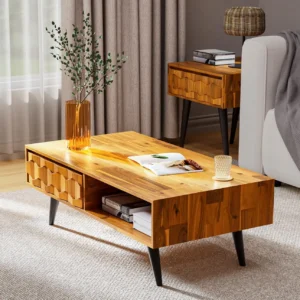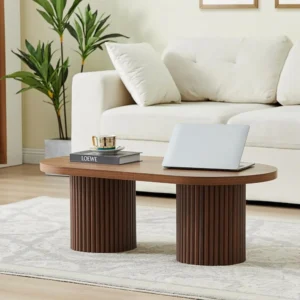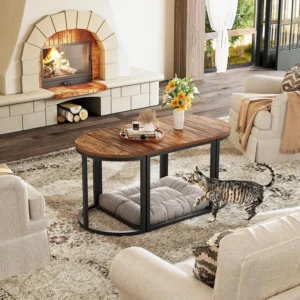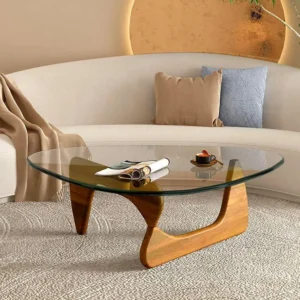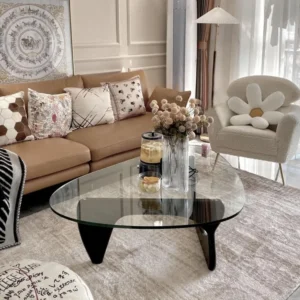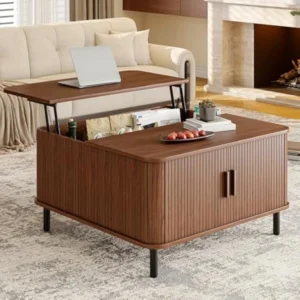The Harmonious Blend: Understanding the Unique Appeal of Oval Tables
Oval tables represent a perfect marriage of form and function in the world of furniture design. Neither fully round nor rectangular, they occupy a special middle ground that combines the soft, flowing lines of circular tables with the practical elongated shape of rectangular ones. This distinctive silhouette creates an immediate visual interest while offering functional benefits that have made oval tables increasingly sought-after in contemporary interior design.
What makes oval tables truly stand out is their remarkable versatility. Their curved edges create a sense of movement and fluidity that rectangular tables simply cannot match, while their elongated form provides the practical seating capacity that round tables often lack. This dual nature allows them to serve as both statement pieces and practical solutions for various living spaces.
The rising popularity of oval tables in modern homes isn’t merely coincidental. Interior designers have increasingly embraced these tables for their ability to:
- Soften room layouts dominated by straight lines and angular furniture
- Create better traffic flow in dining and living areas
- Accommodate more people than round tables of similar width
- Add visual interest without the harshness of sharp corners
Throughout history, oval tables have evolved from formal dining settings in Victorian homes to becoming centerpieces in mid-century modern designs. Today’s oval coffee table trends show a continued appreciation for their unique combination of elegance and practicality.
As we explore the distinctive features of oval tables, you’ll discover why these curved beauties deserve consideration for your space—whether you’re looking for a statement dining table or a functional mid-century modern oval coffee table for your living room.
The Visual Poetry: Aesthetic Qualities That Define Oval Tables
The oval shape speaks a unique visual language in interior design. Unlike the geometric precision of rectangles or squares, oval forms echo the organic curves found in nature, creating an immediate sense of comfort and harmony. This psychological response to curved shapes is well-documented in design theory—our brains process curves more easily than sharp angles, leading to a subconscious feeling of ease and welcome.
When placed in a room, oval tables guide the eye in a gentle, continuous motion. Rather than stopping abruptly at corners, your gaze flows around the perimeter in one uninterrupted journey. This visual rhythm helps integrate the table with its surroundings, making oval tables particularly effective in creating cohesive spaces that feel thoughtfully designed rather than randomly assembled.
Oval tables command attention without dominating a space. Their form creates a natural focal point—substantial enough to anchor a room yet soft enough to prevent the heavy, imposing presence that some rectangular tables can create. This balance makes them exceptionally versatile across different interior styles, from traditional to contemporary.
The edge profile of an oval table significantly influences its overall character. A simple rounded edge creates a casual, approachable feel, while a beveled edge adds a touch of formality and sophistication. Bullnose edges (fully rounded) offer a soft, child-friendly profile, whereas knife-edge treatments create a more dramatic, modern statement. Light interacts differently with each of these profiles—curved edges catch and diffuse light, creating subtle gradients rather than the sharp highlights and shadows seen on straight-edged furniture.
These defining aesthetic features of round and oval tables help explain their enduring appeal in collections like Hearth Forms’ mid-century modern coffee tables, where form and function achieve perfect harmony.
Beyond Beauty: Practical Advantages of Oval-Shaped Tables
While the aesthetic appeal of oval tables is immediately evident, their practical benefits are equally compelling. These advantages extend far beyond mere looks, addressing real-world concerns about space usage, seating capacity, and safety.
Space optimization tops the list of practical benefits. The absence of sharp corners means oval tables effectively “shrink” in tight spaces, providing about 8-12 inches of additional walking room around each corner compared to rectangular tables of similar dimensions. This extra space makes a significant difference in smaller dining rooms or in open-concept areas where traffic flow is essential.
Seating capacity represents another notable advantage:
- Oval tables typically accommodate 1-2 more people than rectangular tables of equal width
- The curved ends allow chairs to be positioned at varying angles, unlike the rigid grid of a rectangular table
- Guests can sit closer together at the curved sections without feeling cramped
- Flexible seating arrangements make oval tables ideal for both intimate dinners and larger gatherings
Social dynamics improve around oval tables as well. Their shape promotes more inclusive conversation patterns, as the gentle curve allows people to partially face more of their fellow diners. This subtle adjustment creates a more engaging social experience compared to long rectangular tables where end-seated guests may feel disconnected from conversations happening at the opposite end.
Safety considerations make oval tables particularly attractive for households with young children or elderly members. The absence of sharp corners reduces the risk of painful bumps and injuries—a small but significant detail for families. This safety feature alone makes oval coffee tables that enhance room flow increasingly popular choices for multi-generational homes.
The ongoing debate between oval vs. rectangular coffee tables often comes down to these practical considerations. While rectangular tables maximize seating along their lengths, oval tables often prove more adaptable to varying needs and spatial constraints.
Material Matters: Surface Options for Oval Tables
The material selection for an oval table profoundly influences not just its appearance but also its functionality, durability, and maintenance requirements. Each material brings unique characteristics that can enhance or define the table’s role in your space.
Wood
Wood remains the most popular choice for oval tables, offering warmth, character, and versatility.
Pros:
– Natural beauty with unique grain patterns
– Available in numerous species, from light maple to rich walnut
– Adapts to various styles from rustic to refined
– Can be refinished to address wear or style changes
Cons:
– Requires protection from moisture and heat
– Solid wood options tend to be heavier and more expensive
– Some species may darken or change color with age
Solid wood constructions offer superior durability and aging potential, while veneered options provide the look of premium woods at more accessible price points.
Glass
Glass tops create a distinctly contemporary feel and visual lightness.
Pros:
– Creates an airy, space-enhancing impression
– Allows base designs to remain visible
– Extremely easy to clean
– Resistant to staining
Cons:
– Shows fingerprints and dust more readily
– May cause anxiety for households with children
– Heavier than it appears, especially with thicker tempered glass
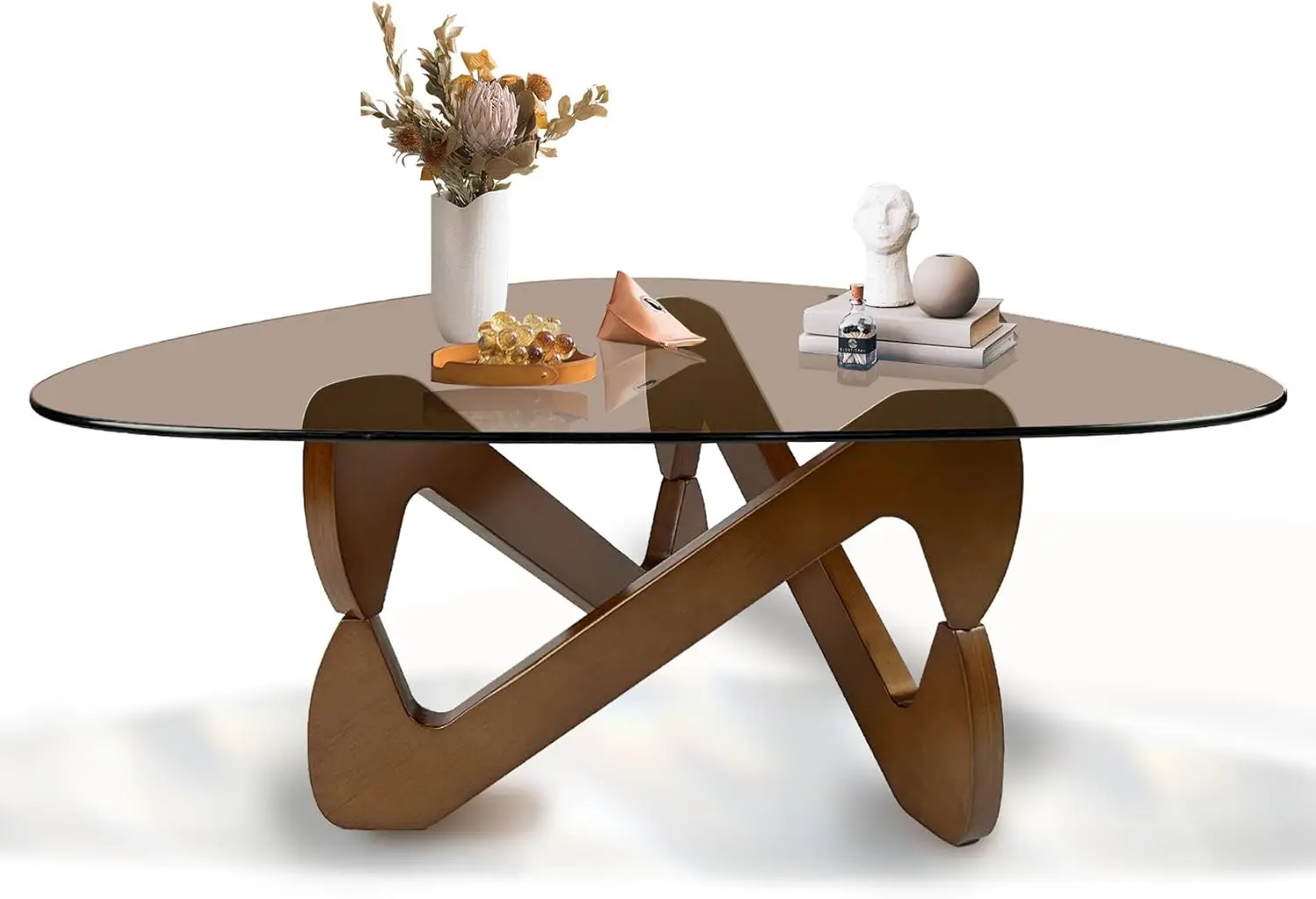
Tempered glass offers significantly improved safety over standard glass, breaking into small, relatively harmless pieces rather than dangerous shards if damaged.
Stone
Stone tabletops bring natural elegance and substantial presence.
Pros:
– Unmatched luxury appearance
– Each piece has unique patterns and character
– Extremely durable when properly sealed
– Resistant to heat damage
Cons:
– Very heavy, requiring robust base support
– Higher maintenance with periodic sealing needs
– Premium cost, especially for larger tables
– Can chip or crack if struck with force
The design elements of marble mid-century tables showcase how natural stone can be incorporated into even the most refined design traditions.
Metal and Engineered Materials
Metal and engineered surfaces offer contemporary alternatives with practical benefits.
Pros:
– Consistent appearance without natural variations
– Generally very durable and resistant to damage
– Lower maintenance requirements
– Often more affordable than natural materials
Cons:
– May lack the warmth and character of natural materials
– Can feel cold or industrial without softening elements
– Quality varies significantly across price points
The material choice significantly impacts not just appearance but also the table’s weight, maintenance needs, and longevity. For a stunning visual statement, explore Hearth Forms’ mid-century modern glass top coffee tables that showcase this perfect marriage of form and material.
Foundation & Form: Base Designs and Their Impact
While tabletops may initially catch the eye, the base design of an oval table plays a crucial role in both its stability and visual impact. The base must not only support the weight of the top but also complement its shape while providing practical considerations like legroom and balance.
Pedestal Bases
Single Central Pedestal
– Creates a dramatic, sculptural appearance
– Maximizes legroom by eliminating corner legs
– Allows chairs to be placed anywhere around the perimeter
– Best suited for smaller to medium oval tables
– Requires careful weight distribution to maintain stability
Double Pedestal
– Provides excellent support for larger oval tables
– Creates a formal, substantial appearance
– Offers good legroom with strategic placement
– Can incorporate more elaborate design elements
– Typically features connecting stretchers for added stability
Trestle Designs
- Features two vertical supports connected by a horizontal beam
- Traditional style with contemporary applications
- Provides excellent stability for longer oval tables
- May limit chair placement at the ends
- Creates distinct visual rhythm that complements oval shapes
Four-Leg Configurations
- Most traditional and structurally straightforward design
- Provides clear visual boundaries at corners
- Can range from simple tapered legs to elaborate carved designs
- Excellent stability but may restrict legroom at corners
- Works well when legs are inset from the table’s edge
Sculptural or Artistic Bases
- Creates statement pieces where the base becomes a focal point
- Often features asymmetrical or organic forms
- Celebrates the material through visible craftsmanship
- May sacrifice some functional aspects for aesthetic impact
- Best showcased with glass tops that don’t obscure the design
The relationship between top and base should feel harmonious rather than forced. Thicker, substantial tops generally pair well with equally robust bases, while thinner tops float elegantly above more delicate supports. Material continuity—or deliberate contrast—between top and base creates cohesive design statements.
Hearth Forms’ collection of mid-century modern solid wood coffee tables exemplifies thoughtful base designs that complement their oval tops while honoring authentic design principles.
Mid-Century Modern Solid Wood Coffee Tables, Mid-Century Modern Teak Coffee Tables
$879.95 Select options This product has multiple variants. The options may be chosen on the product pageMid-Century Modern Danish Coffee Tables, Mid-Century Modern Oval Coffee Tables, Mid-Century Modern Solid Wood Coffee Tables
$390.05 Select options This product has multiple variants. The options may be chosen on the product pageMid-Century Modern Coffee & End Table Sets, Mid-Century Modern Coffee Table Sets, Mid-Century Modern Oval Coffee Tables
Price range: $257.48 through $331.04 Select options This product has multiple variants. The options may be chosen on the product pageMid-Century Modern Glass Top Coffee Tables, Mid-Century Modern Glass Top Side & End Tables
$460.58 Select options This product has multiple variants. The options may be chosen on the product pageMid-Century Modern Glass Top Coffee Tables, Mid-Century Modern Vintage Coffee Tables, Mid-Century Modern Vintage Side & End Tables
$725.36 Select options This product has multiple variants. The options may be chosen on the product pageMid-Century Modern Lift Top Coffee Tables, Mid-Century Modern Square Coffee Tables
$454.73 Select options This product has multiple variants. The options may be chosen on the product page
Finding Your Perfect Match: Selecting the Right Oval Table
Finding the ideal oval table requires balancing aesthetic preferences with practical considerations. The right dimensions ensure your table fits comfortably in your space while accommodating your typical needs.
Sizing Guidelines
Start by measuring your available space, keeping in mind these clearance requirements:
– Minimum 36 inches between table edges and walls/furniture
– Additional 24-30 inches behind each chair for comfortable movement
– Extra circulation space in high-traffic pathways
For dining tables, typical oval dimensions include:
– Small (4-6 people): 60” × 36-42”
– Medium (6-8 people): 72” × 42-48”
– Large (8-10 people): 84-96” × 48”
For coffee tables, appropriate dimensions are generally:
– Small/medium rooms: 42-48” × 24-30”
– Larger living rooms: 54-60” × 30-36”
Remember that table height matters too—standard dining height is 29-30 inches, while coffee tables typically stand 16-18 inches tall.
Oval Variations
Not all oval tables share identical shapes. Common variations include:
- Standard oval: Perfectly symmetrical with equal curves at both ends
- Racetrack oval (stadium shape): Featuring straight parallel sides with semicircular ends
- Danish oval: Slightly more organic with softly flaring sides
- Surfboard oval: Elongated with narrower, more pointed ends
Each variation creates a subtly different visual impact and may better suit certain room shapes or design styles. The Danish oval, for instance, has become a signature element in mid-century modern Danish coffee tables.
When selecting your oval table, consider how you’ll typically use it. For regular family meals, prioritize comfortable daily seating. For frequent entertaining, a slightly larger option with expandable capabilities might be worth considering.
Learning how to perfectly style an oval coffee table will help you maximize both the functional and decorative potential of your selection, regardless of which specific variation you choose.
Shape Comparison: How Oval Tables Stack Up
Understanding how oval tables compare to other common shapes helps clarify when they might be the ideal choice for your space and needs.
Oval vs. Rectangular Tables
Rectangular tables remain the most common choice, but oval tables offer distinct advantages:
– Oval tables remove 8-12 inches of corner protrusion that can obstruct traffic flow
– Both shapes accommodate similar numbers of people in the same footprint
– Rectangular tables maximize seating along the long edges
– Oval tables create more flexible seating arrangements
– Rectangular tables often appear more formal or traditional
– Oval tables soften room dynamics and create better conversation flow
Oval vs. Round Tables
While both feature curved edges, the difference in shape creates significant functional distinctions:
– Oval tables seat more people than round tables of the same width
– Round tables create the most democratic seating arrangement where everyone faces each other
– Oval tables work better in rectangular rooms, while round tables excel in square spaces
– Round tables can create awkward spacing in rectangular rooms
– Both shapes eliminate the safety concerns of sharp corners
Oval vs. Square Tables
Square tables present their own unique advantages and limitations:
– Square tables create the most space-efficient seating for exactly four people
– Oval tables adapt better to different group sizes
– Square tables reinforce symmetry and geometric order
– Oval tables soften room dynamics with flowing lines
– Square tables often feel more substantial and anchored
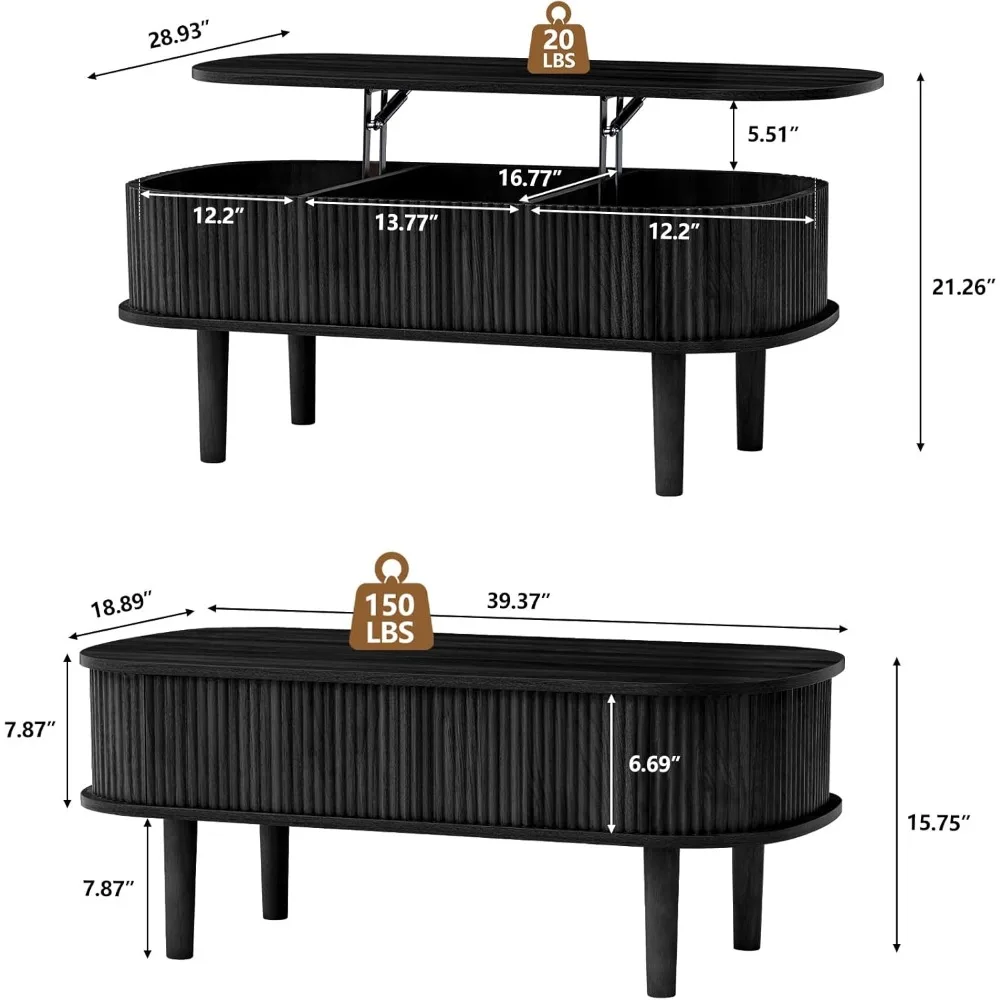
When choosing the perfect coffee table, consider how each shape interacts with your existing furniture arrangement. Oval tables excel in rooms where:
– Traffic flow around the table is a concern
– The space is rectangular rather than square
– Existing furniture features predominantly straight lines that could benefit from contrast
– Flexibility in seating arrangements is valued
– A softer, more organic aesthetic is desired
Each shape has its ideal application, with oval tables offering perhaps the most versatile middle ground between the intimate circularity of round tables and the efficient formality of rectangular ones.
Styling Success: Design Tips for Your Oval Table
Once you’ve selected the perfect oval table, thoughtful styling enhances its impact while maximizing functionality. These design strategies help create cohesive, balanced arrangements that showcase your table’s unique qualities.
Chair Selection and Arrangement
The right chairs complement your oval table’s curves while providing comfortable seating:
– Mix armchairs at the ends with side chairs along the lengths for visual interest
– Consider chairs with curved backs that echo the table’s shape
– Allow 24 inches of table edge per person for comfortable dining
– For dining tables, ensure chair heights provide 10-12 inches between seat and tabletop
– Explore mixed seating with benches along straight sides and chairs at curved ends
Centerpieces and Accessories
Decorative elements should enhance rather than overwhelm your table’s form:
– Choose oval or elongated centerpieces that mirror the table’s shape
– Create a “runway” arrangement for longer oval tables rather than a single central element
– Use odd numbers of items (3, 5, 7) for more dynamic arrangements
– Consider height variation—tall elements at the center flanked by lower items
– Allow the wood grain or material pattern to remain partially visible
Lighting Considerations
Proper lighting dramatically enhances your oval table’s presence:
– Center a single pendant or chandelier over round or small oval tables
– Use multiple pendants or an elongated fixture for larger oval tables
– Position the bottom of hanging fixtures 30-36 inches above the table surface
– Consider dimmable options to adjust atmosphere for different functions
– Ensure lighting diameter is approximately 1/2 to 2/3 the table’s width
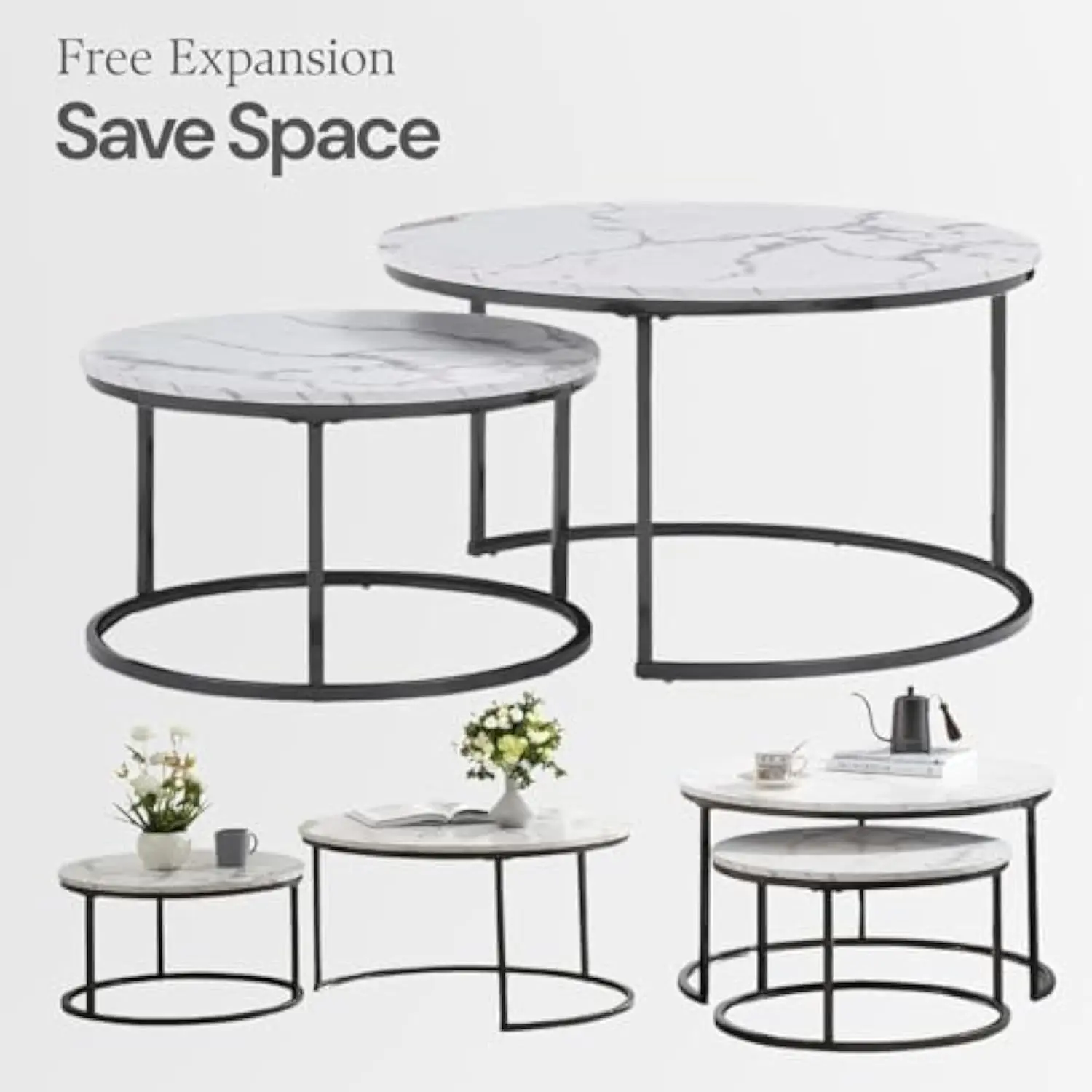
Seasonal Adaptations
Refresh your table’s appearance throughout the year:
– Use table runners that follow the oval’s length rather than typical rectangular runners
– Incorporate seasonal elements that maintain the table’s curved visual theme
– Adjust centerpiece height based on the formality of the occasion
– Consider table leaves or extensions for holiday gatherings
– Use placemats rather than full tablecloths to highlight the oval shape
These styling strategies help when mastering the mid-century oval coffee table aesthetic or creating your own unique look. Remember that negative space is as important as decorative elements—allow your table’s natural beauty and form to remain a visible foundation of your design.
Frequently Asked Questions About Oval Tables
How many people can typically sit at an oval table?
The seating capacity depends primarily on the table’s dimensions. As a general guide:
– A 60-inch oval table comfortably seats 4-6 people
– A 72-inch oval table accommodates 6-8 people
– An 84-inch oval table fits 8-10 people
– A 96-inch oval table can seat 10-12 people
Oval tables typically seat 1-2 more people than rectangular tables of similar dimensions due to the curved ends allowing more flexible seating arrangements.
Are oval tables good for small spaces?
Yes, oval tables are excellent choices for smaller rooms. The rounded corners take up less visual and physical space than rectangular tables, improving traffic flow and reducing the risk of bumping into sharp corners. Their elliptical shape also creates a sense of openness that helps a small room feel less crowded.
What’s the difference between a racetrack oval and a regular oval table?
A regular oval table has a continuous curve around its entire perimeter. A racetrack oval (sometimes called a stadium shape) features straight parallel sides with semicircular ends, resembling a running track. The racetrack design typically provides more usable surface area and can appear slightly more formal or structured than a true oval.
What kind of chairs work best with oval tables?
Oval tables pair well with most chair styles, but chairs with curved elements often create the most harmonious look by echoing the table’s shape. Consider mixing chair styles—perhaps armchairs at the ends with side chairs along the length—to create visual interest while maintaining balance. Ensure chairs aren’t too bulky for the table scale.
How do I measure for an oval table?
Measure the maximum length and width your space can accommodate, then subtract at least 36 inches from each dimension to allow proper clearance for chairs and movement. Remember that an oval table’s curved edges mean the full width is only present at the center, tapering toward the ends—this natural tapering actually helps maximize space efficiency.

